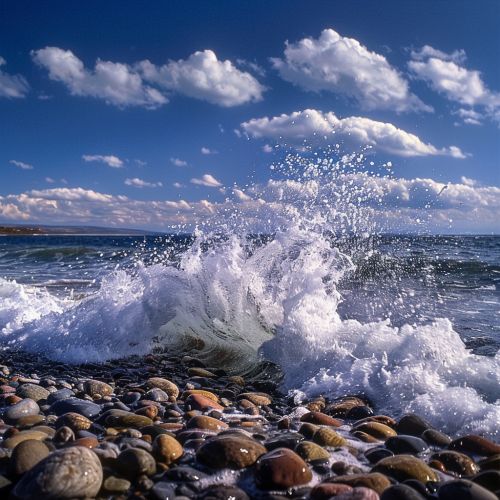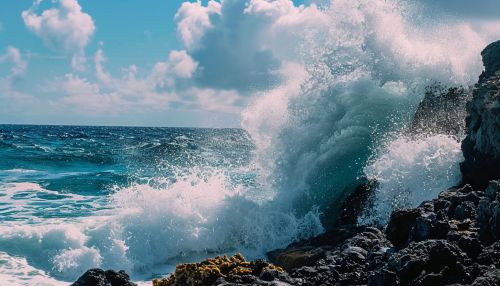The Sea Around Us
Introduction
The sea around us is a vast and complex ecosystem that covers approximately 71% of the Earth's surface. It plays a crucial role in regulating the planet's climate, supporting a diverse array of life forms, and providing resources and services essential to human societies. This article delves into the various aspects of the sea, including its physical properties, biological diversity, ecological significance, and the human interactions that shape its current state.
Physical Properties of the Sea
The sea's physical properties are fundamental to understanding its behavior and influence on the global environment. These properties include salinity, temperature, density, and the movement of water masses.
Salinity
Salinity refers to the concentration of dissolved salts in seawater, typically measured in parts per thousand (ppt). The average salinity of the world's oceans is about 35 ppt, though it can vary significantly depending on factors such as evaporation, precipitation, river inflow, and ice formation. Salinity affects the density and buoyancy of seawater, influencing ocean circulation patterns.
Temperature
Sea surface temperature (SST) varies with latitude, depth, and seasonal changes. The temperature of seawater decreases with depth, creating a thermocline—a layer of rapid temperature change. SST influences weather patterns, marine life distribution, and the formation of phenomena such as El Niño and La Niña.
Density
The density of seawater is determined by its temperature and salinity. Colder, saltier water is denser and tends to sink, while warmer, less salty water is less dense and rises. This density-driven movement, known as thermohaline circulation, is a key component of the global ocean conveyor belt, which redistributes heat and nutrients around the planet.
Ocean Currents
Ocean currents are large-scale water movements driven by wind, the Earth's rotation, and differences in water density. These currents can be surface currents, like the Gulf Stream, or deep-water currents that form part of the thermohaline circulation. Ocean currents play a vital role in regulating climate, transporting heat, and supporting marine ecosystems.


Biological Diversity
The sea is home to an extraordinary array of life forms, from microscopic plankton to the largest animals on Earth, such as the blue whale. Marine biodiversity is essential for the health and stability of ocean ecosystems.
Plankton
Plankton are small, often microscopic organisms that drift with ocean currents. They are divided into phytoplankton (plant-like) and zooplankton (animal-like). Phytoplankton, such as diatoms and dinoflagellates, perform photosynthesis and form the base of the marine food web. Zooplankton, including copepods and krill, feed on phytoplankton and are, in turn, preyed upon by larger animals.
Marine Invertebrates
Marine invertebrates encompass a wide range of species, including mollusks, crustaceans, and echinoderms. Mollusks, such as clams, oysters, and squid, have soft bodies and often possess shells. Crustaceans, including crabs, lobsters, and shrimp, have exoskeletons and jointed limbs. Echinoderms, such as sea stars and sea urchins, are characterized by their radial symmetry and spiny skin.
Fish
Fish are a diverse group of vertebrates that inhabit various marine environments, from shallow coastal waters to the deep sea. They are classified into three main groups: jawless fish (Agnatha), cartilaginous fish (Chondrichthyes), and bony fish (Osteichthyes). Fish play a crucial role in marine food webs and are a vital resource for human consumption.
Marine Mammals
Marine mammals, such as whales, dolphins, and seals, are adapted to life in the ocean. They are warm-blooded, breathe air, and give birth to live young. Marine mammals are often top predators in their ecosystems and are important indicators of ocean health.
Coral Reefs
Coral reefs are diverse underwater ecosystems formed by colonies of coral polyps. These reefs provide habitat for a vast array of marine species and are often referred to as the "rainforests of the sea." Coral reefs are highly sensitive to environmental changes, such as ocean acidification and warming, which threaten their survival.
Ecological Significance
The sea plays a critical role in maintaining the Earth's ecological balance. It regulates climate, supports biodiversity, and provides ecosystem services that are essential for human well-being.
Climate Regulation
The ocean absorbs and stores large amounts of heat from the sun, helping to regulate the Earth's climate. It also acts as a carbon sink, absorbing carbon dioxide from the atmosphere and mitigating the effects of global warming. Ocean currents distribute heat around the globe, influencing weather patterns and climate systems.
Nutrient Cycling
The sea is a crucial component of the global nutrient cycle. Nutrients such as nitrogen, phosphorus, and iron are cycled through marine ecosystems, supporting the growth of phytoplankton and other primary producers. Upwelling zones, where deep, nutrient-rich water rises to the surface, are particularly important for marine productivity.
Habitat Provision
The sea provides a wide range of habitats, from shallow coastal areas to the deep ocean floor. These habitats support diverse communities of organisms, each adapted to specific environmental conditions. Coastal habitats, such as mangroves, seagrass beds, and salt marshes, are particularly important for their role in protecting shorelines and supporting fisheries.
Human Interactions
Human activities have a profound impact on the sea, affecting its health and the services it provides. These interactions include fishing, pollution, climate change, and conservation efforts.
Fishing
Fishing is a major human activity that provides food and livelihoods for millions of people worldwide. However, overfishing has led to the depletion of many fish stocks, threatening marine biodiversity and the sustainability of fisheries. Sustainable fishing practices and effective management are essential to ensure the long-term health of marine ecosystems.
Pollution
Marine pollution is a significant threat to ocean health. Sources of pollution include plastic waste, oil spills, agricultural runoff, and industrial discharges. Plastic pollution, in particular, has garnered widespread attention due to its persistence in the environment and harmful effects on marine life. Efforts to reduce pollution and clean up the oceans are critical for protecting marine ecosystems.
Climate Change
Climate change poses a major challenge to the sea and its ecosystems. Rising sea temperatures, ocean acidification, and sea level rise are some of the impacts of climate change on the ocean. These changes can disrupt marine food webs, alter habitats, and increase the vulnerability of coastal communities to extreme weather events.
Conservation
Marine conservation efforts aim to protect and restore ocean ecosystems. Marine protected areas (MPAs), sustainable fisheries management, and habitat restoration projects are some of the strategies used to conserve marine biodiversity. International cooperation and policy frameworks, such as the United Nations Convention on the Law of the Sea (UNCLOS), play a crucial role in marine conservation.
Conclusion
The sea around us is a dynamic and complex system that is vital to the health of our planet. Understanding its physical properties, biological diversity, ecological significance, and human interactions is essential for the sustainable management and conservation of marine resources. As we continue to explore and study the sea, it is imperative to balance human needs with the protection of this invaluable natural resource.
